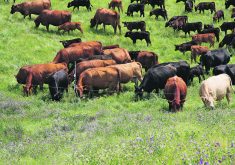Nuclear worry; Asked for funds; Bison cartoon; Strange spending; Beef plan?; Organic markets
Nuclear worry
As a resident of the North Bend district northeast of Lloydminster, I was stunned to discover that neighbours had recently been approached by Bruce Power for land purchases, the primary target for nuclear reactor sites, not to mention extremely disappointed to know the former local MLA was now the company representative.
Why is this government even considering nuclear energy as an option? The high capital cost and cost overruns have cost taxpayers in other areas dearly, not to mention the fact that numerous nuclear projects are faulty and never last as many years as projected. Decommissioning costs are huge as well as accident expenses.
Read Also

Budget seen as fairly solid, but worrying cracks appear
The reaction from the agriculture industry to prime minister Mark Carney’s first budget handed down November 4th has been largely positive.
The long-term health, environment and safety issues are numerous and well documented. Germany did a large study to prove the point before deciding to decommission their nuclear sites and opting for safer alternatives such as wind. You can’t put a price tag on good health.
The reliability of nuclear plants is absolutely pathetic. Why should our tax dollars back such a venture?
Explore other options such as wind, solar and cogeneration expansions. Why waste or risk our clean air and water systems?
Sustainability is another factor. Nuclear is not a renewable source. Other countries have used nuclear energy and are now shutting down these sites. Their past years of experience should not be ignored.
I encourage people to start educating themselves about nuclear energy and standing up to our government with their opinions. I hope Saskatchewan considers the negative impact such a project will have before spending anymore money on nuclear.
– D. Marchadour,
Lloydminster, Sask.
Asked for funds
In a recent article (WP, Feb. 12, “National WI organization celebrates milestone”) in the farm living section about National Women’s Institute organizations, the SWI of Saskatchewan were also mentioned.
While it is true the Saskatchewan WI receives no support from the government, it is definitely not true that we never asked for any, as stated in the article.
After the previous government cut our funding, we made several attempts to reinstate our funding.
Letters were written, meetings with ministers were held. We definitely tried very hard.
Along with the complete funding cut, we also lost our office space at Kirk Hall at the University of Saskatchewan and our close link with that institution.
It was very hard for us to bear. Many years of helping rural women with information and education and spearheading many programs were just swept aside.
We were forced to become a volunteer organization but it is not easy without a central office.
The president has the office at her home and sends out the newsletter but the term is only for three years. Then it moves to the next president.
As current president of the SWI, I wanted to clarify this point.
– Ellen Stachiw,
Yorkton, Sask.
Bison cartoon
This letter is in response to your cartoon about bison for president Obama (Opinion, Feb. 26).
I would like to start off as stating that we are bison farmers and producers alike. We feel that your statement you were attempting to portray was in poor taste towards the bison industry and a slight bit over the wall concerning the suffering of the cattle industry. …
I am not by any means saying that the bison industry is better than the cattle industry. What I am saying, though, is that I am very disappointed in your newspaper printing something as discriminatory as this cartoon.
The bison industry is a very important part of Canada’s heritage as well as the U.S.A.’s. If the person who had decided to print this insult towards the bison industry had done their homework, they would have discovered that president Obama was very intrigued with bison from a young age and was without a doubt impressed to be served such a health smart, tasty, wholesome meat as he was upon his first visit to Canada….
I would like to add to this that it’s not a competition between the cattle and bison industry and that there is plenty of room and compatibility to be had here in Canada and worldwide. There should not be an issue of quantity verses quality here but the overall nutritional value proves that bison is a more health friendly meat than beef. …
– Sheila Soloshy,
Slave Lake, Alta.
Strange spending
The federal budget had no mention of the cattle sector, very little about the grain, yet the government is going to give the railroad companies $60 million to improve the rail lines.
What do the rail companies do with the money that comes off the farmer’s cheque at the time the grain is delivered to the elevator?
The farmers leave a third or more of their cheque at the elevator before it is written, (with) elevation, cleaning, transportation listed as deductions, yet the farmer has fertilizer, spray, trucking, repair and fuel bills come off his cheque when he gets home.
The farmers have to pay for research. Why shouldn’t this come from everyone’s pocket?
The governments open up more rural service centres. Why wouldn’t one big one do, as the farmers have internet nowadays? They can e-mail into the centre instead of building more buildings and hiring all these expensive employees.
Farming is common sense. We’ve swath grazed for 30 years or more, also placing bales here and there for feeding, also have rolled out bales with a bale sled pulled by horses, also have wintered cattle on snow but all of a sudden these techniques are something new….
Our government let our cattle facilities be sold off, such as stockyards, trucking, packing, slaughter plants, feedlots to be owned by one company, so now we have no competition, as they have the monopoly….
– Elaine Cozart,
Brownlee, Sask.
Beef plan?
The Canadian Cattlemen’s Association is very good at name-calling, but sadly lacking when it comes to laying out a coherent plan for increasing the money that farmers and ranchers are receiving for cattle sales.
The CCA affiliates in each province except Alberta collect a checkoff of $2 per head for every animal sold. In Alberta, the CCA affiliate, Alberta Beef Producers , collects even more – $3 per head.
Over the last 20 years, the price of cattle has fallen to half of what it used to be, but farmers are still forced to pay millions of dollars of checkoff taxes on cattle with no choice in where their money goes.
In fact, just since the BSE crisis first hit in 2003, ABP has collected more than $70 million in a per-head tax from farmers/ranchers. So where is the $70 million plan to raise the incomes of Canada’s farmers and ranchers?
Did the CCA think that stopping the government of Canada from opening up the books of the packers during the BSE crisis was a plan to help farmers and ranchers? All that did was make life easier for the packers and prevent the required information from getting back to farmers/ranchers and our decision makers….
Is the CCA opposing the sale of Tyson to XL, a corporate merger that will further kill competition by reducing the Big Three (Cargill, Tyson and XL) to the Big Two (Cargill and XL)? No. …
If you are tired of half-price cattle and want to increase returns to farmers and ranchers, read the NFU’s cattle brief available at www.nfu.ca. You don’t have to agree with everything in the plan, but you won’t find a more comprehensive analysis anywhere, and it is a starting point for change.
– Stewart Wells,
President, National Farmers Union,
Swift Current, Sask.
Organic markets
For years now, farmers have been told how demand for organic products has been increasing 20 percent a year.
But what those sources do not know is how much production has increased all over the world.
Because of this over production and the recession, I and other organic farmers I’ve talked to have not sold a bushel of grain yet.
Buyers are telling me that demand isn’t going to increase anytime soon and that prices are going to drop more in line with conventional grains.
So I urge anyone thinking of converting to organics to research the markets first.
– Hugo Giraudier,
Willow Bunch, Sask.














